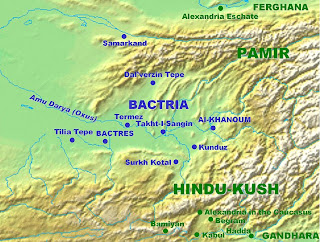Click Here to View the Main Index
"Bactria was the homeland of Indo-European tribes who moved south-west into Iran and into North-Western India around 2500–2000 BC."
Click on the map to enlarge
Bactria (from Βακτριανή, the Hellenized version of Old Persian Bāxtriš; Bactrian: Baktra; Persian/Pashto: باختر Bākhtar; Tajik: Бохтар; Chinese: 大夏 Dàxià; Sanskrit बाह्लीक Bahilka) is the ancient name of a historical region located south of the Amu Darya and west of Gandhara. Ancient Bactria was in present-day northern Afghanistan, between the Hindu Kush mountain range and the Amu Darya. Once Zoroastrian, this region subsequently hosted Buddhism before becoming Muslim after the arrival of the Rashiduns and Umayyads in the 7th century. Bactria was also sometimes referred to by the Greeks as Bactriana.
"The Bactria–Margiana Archaeological Complex (BMAC, also known as the "Oxus civilization") is the modern archaeological designation for a Bronze Age culture of Central Asia, dated to ca. 2200–1700 BC, located in present day eastern Turkmenistan, northern Afghanistan, southern Uzbekistan and western Tajikistan, centered on the upper Amu Darya (Oxus), in area covering ancient Bactria. Its sites were discovered and named by the Soviet archaeologist Viktor Sarianidi (1976). Bactria was the Greek name for Old Persian Bāxtriš (from native *Bāxçiš) (named for its capital Bactra, modern Balkh), in what is now northern Afghanistan, and Margiana was the Greek name for the Persian satrapy of Margu, the capital of which was Merv, in today's Turkmenistan......The early Greek historian Ctesias, c. 400 BC (followed by Diodorus Siculus), alleged that the legendary Assyrian king Ninus had defeated a Bactrian king named Oxyartes in ca. 2140 BC, or some 1000 years before the Trojan War. Since the decipherment of cuneiform in the 19th century, however, which enabled actual Assyrian records to be read, historians have ascribed little value to the Greek account.....According to some writers, Bactria was the homeland of Indo-European tribes who moved south-west into Iran and into north-western India around 2500–2000 BC. Later, it became the north province of the Persian Empire in Central Asia.[3] It was in these regions, where the fertile soil of the mountainous country is surrounded by the Turanian desert, that the prophet Zoroaster (Zarathushtra) was said to have been born and gained his first adherents. Avestan, the language of the oldest portions of the Zoroastrian Avesta, was one of the old Iranian languages, and is the oldest attested member of the Eastern Iranian branch of the Iranian language family."
Email....okarresearch@gmail.com
October 2012


No comments:
Post a Comment